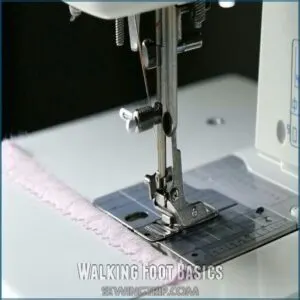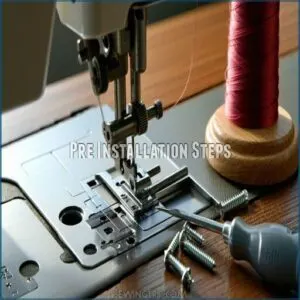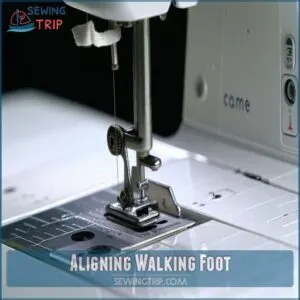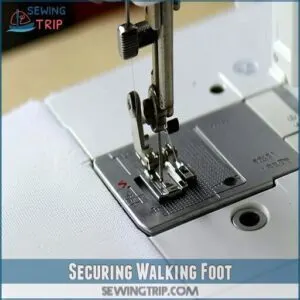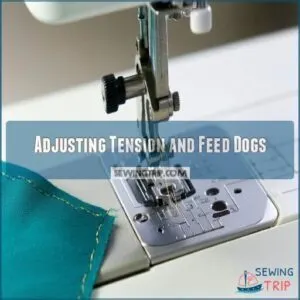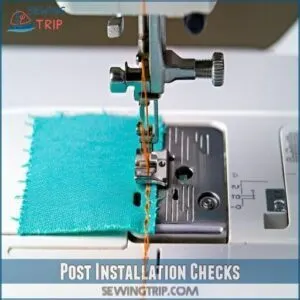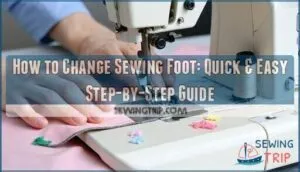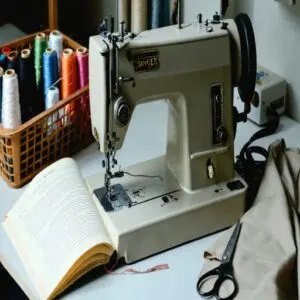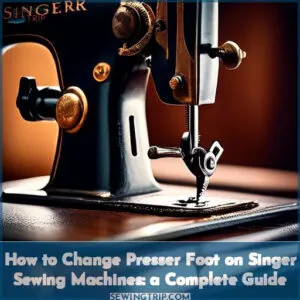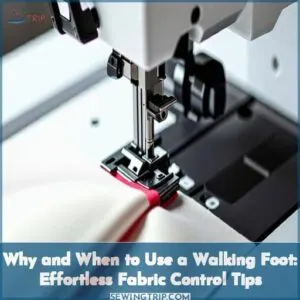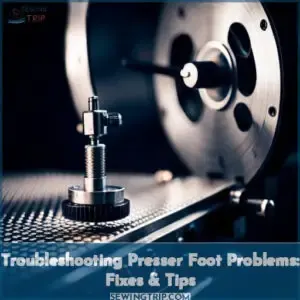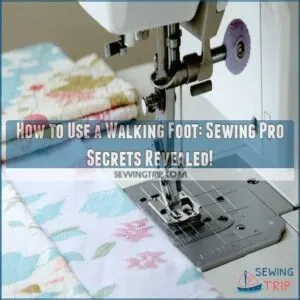This site is supported by our readers. We may earn a commission, at no cost to you, if you purchase through links.
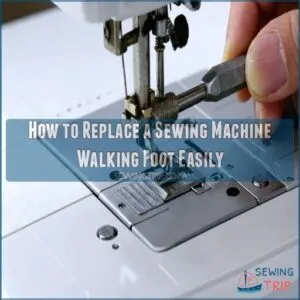
To do this, you’ll remove the old foot using a screwdriver, inspect the machine, and align the new foot with the mounting points.
Secure it with a screwdriver, making sure a proper attachment. This process is essential for even fabric feed and consistent seams.
With the right steps, you’ll be sewing like a pro in no time. Now, let’s get started with the details to make sure a smooth replacement of your sewing machine walking foot.
Table Of Contents
Key Takeaways
- You’ll need to gather necessary tools like screwdrivers and pliers, and prepare your sewing machine by powering it off and removing the presser foot before you can replace the walking foot.
- To install a new walking foot, you’ll align it with the machine’s guide, secure it firmly in place using the provided screws, and adjust the feed dog height and tension for consistent stitch consistency.
- You should test the stitching and quality by sewing a sample fabric with the new walking foot, and check for any issues like misaligned feet, loose screws, or threading errors to ensure everything is working correctly.
- Regular maintenance is key to keeping your walking foot in good condition, so you’ll want to clean and store it properly, removing it, brushing away dust, and drying it thoroughly to prevent common problems and keep it ready for consistent use.
Walking Foot Basics
You’re about to learn the basics of a walking foot, which is an integral component of your sewing machine.
You’ll understand what a walking foot is, its types, and its benefits, helping you to replace it easily and efficiently.
Definition and Purpose
A sewing machine walking foot, also called a dual feed system, is a special presser foot.
It feeds multiple fabric layers evenly, which prevents slippage and gives you enhanced control.
This makes it great for thick fabrics or quilts, providing even fabric feed.
- Even fabric feed
- Prevents slippage
- Multiple layers
- Enhanced control
- Dual feed system
Types of Walking Feet
You’ll find various walking foot types, including Standard, Quilting, and Even Feed Foot.
Each serves a purpose, like the Adjustable Walking Foot for thick fabrics or the Universal Walking Foot for general use, offering different walking feet options to suit your sewing needs with the best walking foot.
A walking foot is invaluable for multi-layer sewing projects, and it is especially useful for tasks that require precision and control.
Benefits of Using a Walking Foot
A walking foot dramatically improves your sewing projects.
It gives you enhanced control, especially with multiple layers or thick fabrics like those used in quilting.
Here’s how it helps:
- Even Fabric Feed
- Reduced Slippage
- Consistent Seams
With a walking foot, you’ll achieve even stitches on layers of fabric. It’s a game-changer for consistent seams.
Replacing Walking Foot
Proper guide bar installation is essential for even quilting.
| Step | Action | Tool |
|---|---|---|
| 1 | Remove old foot | Screwdriver |
| 2 | Inspect machine | None |
| 3 | Align new foot | None |
| 4 | Secure new foot | Screwdriver |
To replace walking foot, remove old foot, then install new one, ensuring secure attachment and proper foot alignment.
Pre Installation Steps
You’re about to replace your sewing machine’s walking foot, and it’s important to start with the right preparation.
You’ll need to gather necessary tools, prepare your sewing machine, and remove the old walking foot before installing the new one, which is a critical step in the process.
Gather Necessary Tools
Now that you’ve decided to replace your walking foot, gather necessary tools like screwdrivers, pliers, and extra needles.
A walking foot screwdriver may be helpful.
Don’t forget your machine manual and cleaning supplies to keep your sewing machine feet in top condition when you detach and attach the new walking foot.
Prepare Sewing Machine
Power off your sewing machine.
Remove the presser foot and raise the presser bar. Consult your manual for specific steps.
Clear any obstructions to access the walking foot area, preparing it for the new attachment, ensuring a smooth install process for your new walking foot on the sewing machine.
Remove Old Walking Foot
To remove the old walking foot, locate its retaining mechanism and release the lever or screws.
Detach the old foot from the sewing machine’s presser foot, then store its components safely.
You can find replacement walking foot products online.
Identify your foot type to confirm correct removal and handle the walking foot with care to avoid damage.
Installation Process
You’re now ready to install your new walking foot, and this process is straightforward.
You’ll align the walking foot with your sewing machine’s guide, then secure it firmly in place using the provided screws.
Aligning Walking Foot
To align the walking foot, verify needle clamp, feed dog, and presser foot alignments match the machine’s mounting points.
Properly place the walking foot lever, avoiding misalignment, and prepare to install the walking foot correctly.
Securing Walking Foot
Make sure proper screw placement and tighten screws firmly for a secure attachment.
Checking foot alignment and pressure for a snug fit on your sewing machine is crucial.
Then install the walking foot to attach it correctly.
Adjusting Tension and Feed Dogs
You’ll adjust the feed dog height and tension for consistent stitch consistency.
Worn or damaged feed dogs can cause uneven stitching and should be replaced.
Maintaining tension and feed dogs ensures even fabric feeding under the walking foot, considering fabric thickness and walking foot pressure for perfect stitch length.
For more detailed information, consult this feed dog adjustment guide.
Post Installation Checks
You’ve installed your new walking foot, now it’s time to check that it’s working correctly.
You’ll test the stitching and quality to verify everything is in order and make any necessary adjustments to get the best results from your sewing machine.
Test Stitching and Quality
You’ll test stitching and quality by sewing a sample fabric with your walking foot.
For best results, consider these quality output tips for sewing.
Check stitch length and quality, adjusting tension as needed for best results on thick seams with your sewing machine, ensuring complete concepts are properly executed.
Troubleshooting Common Issues
You’ll troubleshoot walking foot problems by checking for a misaligned foot, loose screws, or threading errors.
Here are common issues:
- Fabric jams
- Needle problems
- Loose screws.
Fix walking foot issues to guarantee smooth sewing and prevent damage.
Maintenance and Storage Tips
You’ll want to clean and store your walking foot properly.
Remove it, brush away dust, and dry thoroughly. Regular maintenance helps prevent common problems.
Consider dedicated walking foot storage solutions to keep it organized.
Keep it in a safe storage location to avoid loss. This maintains your sewing machine attachments remain in good condition, ready for use.
Frequently Asked Questions (FAQs)
Does a sewing machine have a ‘walking foot’?
You’ll find a walking foot on some sewing machines, it’s a special presser foot that helps with thick or slippery fabrics, and multiple layers, making sewing easier and more precise.
What is the most versatile sewing machine foot?
You’ll discover the walking foot is incredibly versatile, handling thick fabrics, quilting, and slippery materials with ease, making it a must-have for various sewing projects and applications.
Do you need a walking foot for sewing?
You’ll need a walking foot for sewing multiple layers, thick fabrics, or slippery materials to maintain even feeding and prevent bunching or dragging.
This ensures professional-looking results with ease and precision always.
Can you sew tricky knit fabric with a walking foot?
You can sew tricky knit fabrics with a walking foot, it helps maintain even fabric feeding.
Making it suitable for sewing knits, vinyls, and slippery fabrics with ease and control always.
How do you clean a walking foot on a sewing machine?
You unthread the machine, remove the walking foot, and gently brush away dust and residue with a soft cloth for cleaning and maintenance.
How do I install a walking foot?
You’ll install a walking foot by loosening the presser foot holder screw, raising it, and aligning the foot’s forks with the needle clamp bar, then tightening the screw securely.
How do you remove a walking foot from a sewing machine?
You remove a walking foot by loosening the presser foot holder screw, raising it, and detaching the foot from the machine, then storing it safely to prevent loss or damage.
Does a walking foot fit any sewing machine?
Imagine a puzzle piece: a walking foot only fits specific sewing machines, so you’ll need to match it to your machine’s make and model for a perfect fit and smooth operation.
This match is crucial because a walking foot that is compatible with your sewing machine will ensure a smooth operation.
Are all sewing machine feet compatible?
You’ll find that not all sewing machine feet are compatible, so you’ll need to match the foot to your machine’s make and model for a proper fit.
What is the difference between a walking foot and a regular foot?
You’ll notice a walking foot has dual feed dogs for better fabric control, unlike a regular foot, which lacks this feature for handling thick or slippery fabrics.
Conclusion
Replacing a sewing machine walking foot is like changing a car tire – it’s easier than you think.
You’ve now learned how to replace a sewing machine walking foot, so go ahead and give it a try.
Mastering how to replace a sewing machine walking foot will make your sewing projects easier, and you’ll be sewing like a pro in no time with this new skill.
- https://www.pincutsewstudio.com/blog/how-to-install-and-sew-with-a-walking-foot
- http://seekatesew.bigcartel.com/category/quilt
- https://www.instagram.com/seekatesew/
- https://sewcanshe.com/walking-foot-sewing-machine/
- https://konsew.com/blog/feed-dogs-and-fabric-movement-the-role-of-feed-dogs-in-fabric-movement-and-how-to-adjust-or-replace-them

